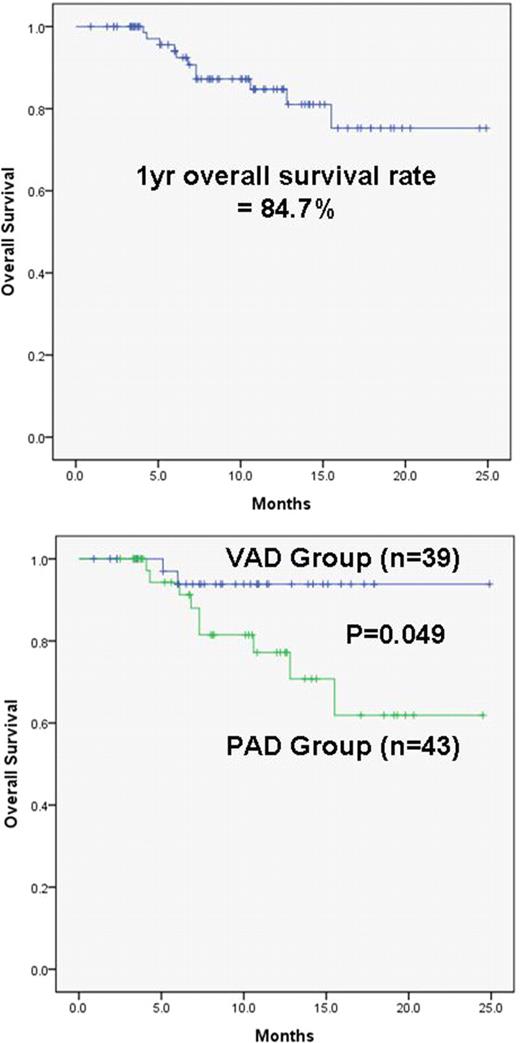Abstract
Abstract 2044
Induction treatment followed by autologous stem cell transplantation (ASCT) is the standard therapy for the newly diagnosed younger patients with multiple myeloma (MM). Although new drugs such as lenalidomide or bortezomib have been shown the promising results as induction treatment, many different type of induction treatment regimens still have been used. We evaluate the efficacy and safety of the short course of high dose dexamethasone (HD dexa) and the response adapted PAD (Bortezomib, Adriamycin, Dexamethasone) or VAD (Vincristine, Adriamycin, Dexamethasone) induction chemotherapy in the newly diagnosed younger patients with MM.
107 newly diagnosed patients with MM from 21 institutions received 2nd cycles of HD dexa followed by PAD or VAD chemotherapy according to the response to the initial high dose dexamethasone. The primary endpoint was complete response (CR) + near CR rate after ASCT. Among 107 patents enrolled this study from November 2009, 25 patients (23%) have been dropped out. This trial will be continued until total 210 patients will be enrolled. The trial is registered on National Cancer Institute website, number NCT01255514.
One hundred seven patients (58 male, 49 female) were enrolled (median age; 56). 26 (24%) light chain disease were included. 31 (29%) patients were D-S stage II and 67 (63%) were stage III. According to the ISS, 23 (22%) patients had stage I, 51 (48%) had stage II and 33 (31%) had stage III. 26 (24%) patients had abnormal cytogenetics. There were 31% del13, 7% del17, 19% t(4;14), 15% t(14;16) and 28% t(11;14) in FISH analysis. Among the 82 evaluable patients, CR + PR rate was 48% (39/82) after 2nd cycles of HD dexa therapy. 39 patients (48%) received subsequent VAD chemotherapy and 43 patients (52%) received PAD chemotherapy. Among the 64 patients finished VAD or PAD chemotherapy, CR + PR rate was 83% (79%, 26/33 in VAD group vs. 87%, 27/31 in PAD group). 56 patients were finished ASCT until now. CR + near CR rate after ASCT were 61% (58% in VAD group vs 63% in PAD group). Mortality rate of this trial was 13% (11/82). The cause of death was disease progression (n=3), bleeding (n=1) and infections (n=7). Among 82 patients in whom VAD or PAD chemotherapy was actually performed, 1 year overall survival (OS) rate was 84.7%. 1 year survival rate was 93.8% versus 77.2% (P=0.049) with VAD versus PAD (median follow-up; 9.1 months).
Risk adapted approach using initial steroid response showed good response results after ASCT compared with previous trial (CR + near CR rate of IFM 2005-01trial-Bortezomib+dexa induction & ASCT was 35%, J Clin Oncol. 2010;28:4621–9) The MM patients who had poor response to HD dexa also showed similar good response rate after ASCT compared with the patients who had good response to HD dexa treatment in this trial. PAD re-induction therapy after failure of initial steroid induction treatment might overcome the inferior results in the high risk MM patients. Therefore, initial steroid response adapted strategy might be the more cost-effective approach in the newly diagnosed ASCT eligible MM patients.
No relevant conflicts of interest to declare.
Author notes
Asterisk with author names denotes non-ASH members.


